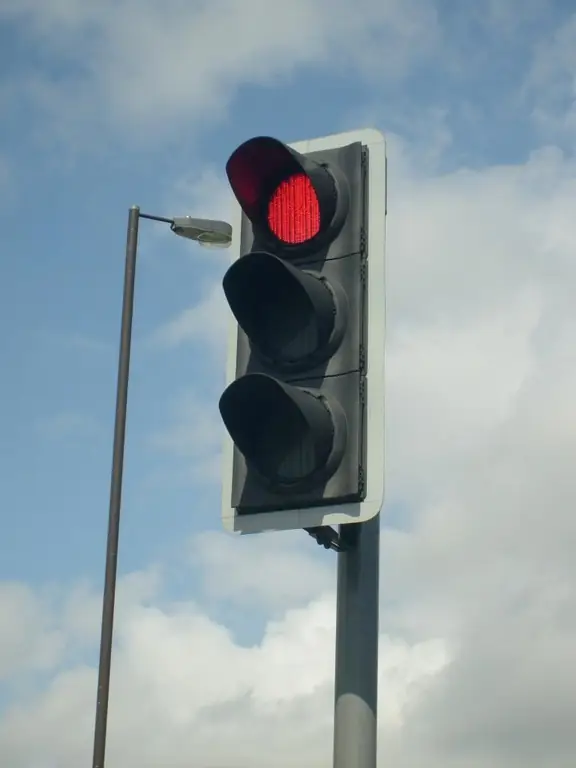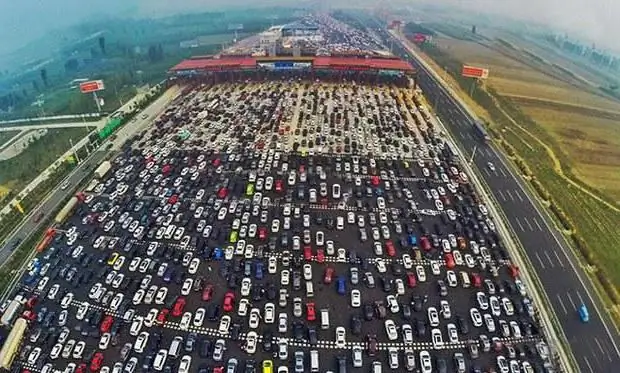2025 Author: Erin Ralphs | [email protected]. Last modified: 2025-01-22 21:14:12
There are situations when the intervention of the traffic controller is necessary at the intersections. He begins his work with a raised right hand and a whistle. Sound accompaniment is necessary to draw the attention of drivers to the fact that now the intersection is regulated by a person, and not by traffic lights, and even more so, priority signs. The raised hand of the traffic controller indicates that all vehicles must stop, except those at the intersection - they are allowed to complete the maneuver, freeing the intersection for the movement of other vehicles.

Controller's signals
According to traffic rules, the traffic controller gives only three signals:
- Extended right arm forward.
- Hand with wand raised up.
- Both arms extended to the right and left or lowered.
Whistle signal
The traffic controller blows his whistle periodically. It is necessary in order to attract the attention of drivers. Such a signal says "drivers, attention,Now everyone is looking at me." Then he gives a certain signal and the vehicles start moving.
Raised hand
When the traffic controller raises his hand, then at this moment all road users must stand. If at this moment someone is at the intersection, then the traffic controller will wait until they complete the maneuver. Those who need to brake sharply at a stop can also pass on a signal of a raised hand. Usually, during a raised hand, there is also a sound notification with a whistle.
When the traffic controller's hand is raised, everyone should stand: trackless vehicles, trams, pedestrians, cyclists. And only after changing position, you can continue to move.

Hands to the sides or down at the seams
According to the traffic rules, the traffic controller, whose hands are lowered at the seams or spread apart, shows the same signals. According to the rules, in this case, the participants in the movement, located in front and behind, cannot continue to move - they stand. But on the right and left sides of the traffic controller, the movement continues. With such a signal, you can move so that the line of hands does not intersect, i.e. straight and right / left (depending on which side the traffic police officer stands: with the right shoulder - we go right or straight, with the left - left or straight). At this moment, pedestrians pass where traffic is prohibited, i.e. in front and behind the controller. Trams can only move by hand, as if entering one sleeve and leaving the other(straight).

Right hand forward
At this signal from the traffic controller, all vehicles to the right of the traffic controller must stand still. Such a signal resembles a barrier, travel with it is prohibited. Those road users who are facing the stick can only drive to the right.
All trams, cars located from the back of the traffic controller must stand - you can’t ride on your back, but pedestrians can cross the street, moreover, only behind the back of the traffic controller.
The most advantageous position is obtained by drivers who are to his left and stand from his left shoulder, and the stick looks to the left. In this position, drivers can move in any direction. But if the carriageway has two or more one-way lanes, then you can move only in those directions where the lane allows: from the extreme right - only to the right and straight ahead, from the extreme left - straight ahead, left and in the opposite direction, from the central one - only straight ahead.
The tram can only move along the arm and body. For example, the traffic controller is turned to the tram with his left side, his right hand looks forward. All participants in the movement of trackless vehicles, located from the back, stand. Also standing are those for whom a “barrier” was created with a rod, i.e. traffic participants located on the right shoulder. Cars from the left shoulder can go in any direction, but the tram only with the letter “G”, i.e. along the chest and further in the direction of the wand. In this case, he will turn in the direction in which the wand points, to the left. The same goes for the rightsides. If the tram is on the right shoulder, then the tram will be able to go horizontally across the chest and further in the direction where the wand points. Trams are not allowed to travel in other directions.
To make it easier to remember the signs, we came up with a funny verse.

Other signals
The traffic controller on the road most often uses not only classic signals, but also additional signs. He can give other signs to road users with a loudspeaker, whistle, hands, baton, but only so that the driver understands what needs to be done.
In practice, traffic controllers usually use the main three signals, supplementing them with other signs. This is due to the fact that most drivers simply do not remember the rules and do not know what exactly the traffic police officer shows. As a reminder, you can watch the video:

Controller priority
It is not enough to know the meaning of the signals of the traffic controller, also the traffic participants must know that he is considered the most important on the road. So, if the intersection is regulated by a traffic light signal, then after the exit of the traffic controller, it becomes the main one and you need to focus on the signals that it shows. The same goes for some road signs - they are cancelled. These include priority signs.

According to the rules, the signals of the traffic controller must be carried out by all road users, even cars with special signals - a siren and a flashing beacon. Failure to comply with regulations, travel on prohibitorysignals are a violation of the law. According to the law, in accordance with Article 12.12 of the Code of Administrative Offenses, for the first violation a fine of 800 to 1000 rubles. Repeated violation entails a fine of up to 5 thousand rubles and deprivation of rights for up to 6 months.
Recommended:
SDA paragraph 6: what does the flashing green traffic light mean, how to navigate the traffic light correctly

From childhood, we are familiar with traffic lights, but in detail the features of their work are studied only by drivers. They know what a flashing green traffic light means and what pitfalls are hidden behind these artificial traffic controllers. In paragraph 6 of the SDA (except for paragraphs 6.10-6.12) talks about how to navigate by traffic lights, and what types of these devices exist
Diagnostic card online: reviews and design rules

In accordance with the first part of the fourth article 40-FZ, which regulates the mandatory liability insurance of vehicle owners, owners of cars registered in the Russian Federation must purchase OSAGO insurance (with the exception of some cases). According to reviews, a diagnostic card for OSAGO online is also issued
Signals of the traffic controller. Memo to the motorist

There are 4 types of traffic control: traffic lights, markings, road signs and signals of the traffic controller. Drivers must strictly follow them all. However, according to the "Rules of the Road", the signals of the traffic controller are priority
Traffic controller gestures: main positions and decoding

If you do not yet perceive the traffic controller as an evil employee who can only create problems, but remember that the policeman on the road is the first assistant, the gestures of the traffic controller will become much easier to understand
The biggest traffic jam in the world. Interesting facts about traffic jams

Many would like to be transported back to ancient times, because it seems that life was much easier back then. Clean air, fewer people, and most importantly - no traffic jams! You will be surprised, but the first traffic jams appeared in antiquity. Where did it all start and where is the biggest traffic jam in the world?

